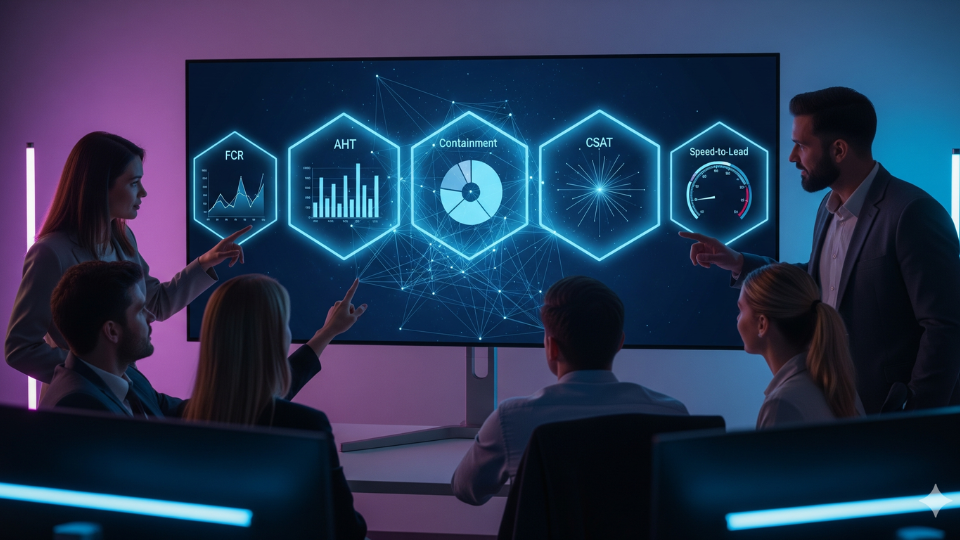The Five Metrics That Matter for Voice AI in 2025: FCR, AHT, Containment, CSAT, Speed-to-Lead

As a contact center manager or business leader, you’ve likely felt the pressure to justify your investment in voice AI. It’s one thing to have a cool new piece of technology; it’s another to prove it’s delivering tangible value to your bottom line and your customer experience. In 2025, a much more sophisticated set of key performance indicators (KPIs) reveals the true impact of your voice AI. These five metrics (First Call Resolution, Average Handling Time, Containment Rate, Customer Satisfaction, and Speed-to-Lead) tell a complete story of efficiency, effectiveness, and revenue generation. They provide the data you need to optimize your AI and demonstrate its power as a core business asset.
First Call Resolution (FCR): The Efficiency and Satisfaction Engine
First Call Resolution is a foundational metric that measures the percentage of customer issues resolved on the first contact without requiring a follow-up call or transfer. For voice AI, a high FCR signals that your system is accurately understanding caller intent and providing the correct information or action on its own. It directly impacts both operational efficiency and customer satisfaction. When a customer’s problem is solved immediately, they don’t have to call back, which reduces your overall call volume and frees up human agents for more complex issues. A high FCR proves that your AI isn’t just a diversion; it’s a resolution engine.
Average Handling Time (AHT): The Time-Saving Power of AI
Average Handling Time measures the total duration of a customer interaction, from the moment a call begins to the moment it ends. Voice AI can dramatically reduce AHT by eliminating hold times, automating data collection, and providing instant answers to frequently asked questions. For example, an AI can process a balance inquiry or a flight status check in seconds, whereas a human agent might take a minute or more to access the same information. When a call is escalated to a human, the AI can seamlessly transfer a complete transcript and all relevant customer information, shortening the human agent’s handling time. This efficiency gain not only lowers operational costs but also improves the customer experience by getting them the information they need, fast.
Containment Rate: Proving the AI’s Independence
Containment Rate is the percentage of calls that an AI successfully handles from start to finish without escalating to a human agent. This metric is a direct measure of your voice AI’s effectiveness and its ability to act as a true first point of contact. A high containment rate means your AI is correctly understanding and resolving a wide range of customer queries, from routine tasks to more complex requests. It proves the system is robust and that your training data and routing logic are well-designed. While a high containment rate is a goal, it shouldn’t come at the expense of a good customer experience. It is important to also monitor for signs of customer frustration and provide an easy path to a human agent when needed.
Customer Satisfaction (CSAT): The Ultimate Human-Centered Metric
Customer Satisfaction is a direct measure of how happy customers are with their experience, often gathered through a post-call survey. While the other metrics focus on operational efficiency, CSAT gets to the heart of the matter: do your customers like interacting with your voice AI? A positive CSAT score shows that your AI’s voice, cadence, and conversational flow are natural and helpful. It means the system is not just accurate but also empathetic and easy to use. The best AI systems don’t just solve problems, they make customers feel heard and valued. Prioritizing CSAT ensures that your voice AI is a long-term asset that builds customer loyalty, not a tool that just ticks boxes.
Speed-to-Lead: The New Revenue Driver
Speed-to-Lead is the time it takes for a new lead to be contacted after their initial inquiry. While traditionally a sales and marketing metric, voice AI has become a game-changer here. When a potential customer fills out a form or calls after hours, a voice AI can immediately reach out with an automated call, text, or email. The AI can then qualify the lead by asking a few key questions and provide an immediate, personalized response. This instant engagement dramatically increases the likelihood of conversion. When a hot lead is contacted within minutes instead of hours, the chances of them moving on to a competitor plummet. Speed-to-Lead proves that your AI is not just a cost-saving tool but a powerful revenue-generating machine.
In 2025, the conversation around voice AI has shifted from “what can it do?” to “what value is it delivering?” By focusing on these five metrics (FCR, AHT, Containment, CSAT, and Speed-to-Lead) you move beyond simple adoption and into a strategic, data-driven approach. These KPIs offer a comprehensive view of your voice AI’s performance, from its operational efficiency and cost-saving abilities to its direct impact on customer loyalty and revenue growth. They provide the actionable insights you need to continuously optimize your AI, ensuring it remains a powerful and effective asset for your business. Are you measuring the metrics that truly matter?








































